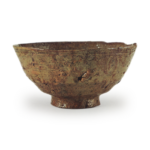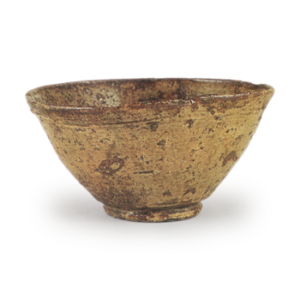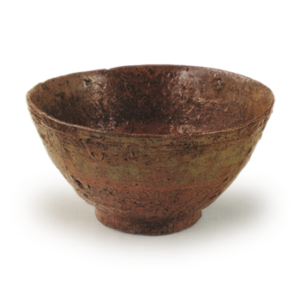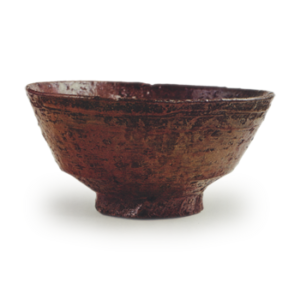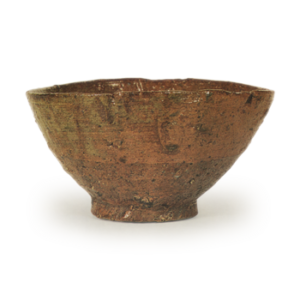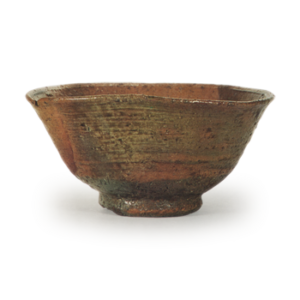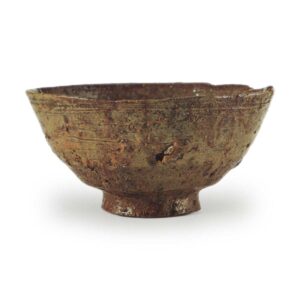
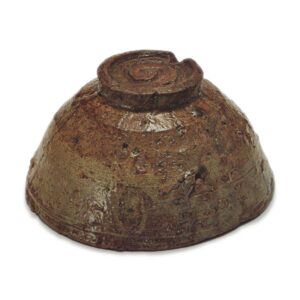
Name: Oimatsu
Height: 7.1cm
Diameter: 13.8-14.3cm
Foot diameter: 5.9cm
Height: 1.0cm
The autumn mountains have been called the Irahosanzan bowls, along with the Saga no Aki and Ryohiko, and are said to be the best in the world. The glaze is reminiscent of the autumn scenery of the mountains, with their alternating reds and greens, and this is the reason for the name. The wabi-like appearance of the stone in the front is also appropriate for the name, and in terms of shape, workmanship and glaze, it is certainly the highlight of the collection. It was later renamed “Oimatsu” by Masuda Dono.
There is no cut around the rim, but there is a beveled rim, and there are two sharp cuts from the side of the foot ring, which adds a sense of refinement and charm to the shape. The overall surface is covered in a thin layer of Iroha glaze, and there are many areas with uneven coloration and puddles of glaze. The luster of the glazed surface is particularly strong around the foot of the vessel, where the glaze is thin, and the blue-green color of the glaze and the reddish color of the glaze are intricately intermingled, giving the appearance of moss or caramelized sugar. In addition, the countless small and large stones, as well as the fine lines of the pull marks, are intricately interwoven, making it the perfect setting for a wabi-mono. The inside of the bowl is reddish with a faint glaze, and there are six faint eyes. Above this, the color becomes bluish, creating a wonderful contrast between red and green.
The foot is unglazed earthenware, and although it is not a bamboo joint, it is strong and one side is broken off. The inside is flat, and there is a curved dent that looks like it has been carved strongly with a thick nail. The hands all have the same habits, and it seems that they were made by the same person, but they are all high-quality works. There are two lines of incising facing each other.
Although the design is full of artistic intent, such as the mountain path, beveled edge and nail carving, the artificiality is not noticeable, and it has a more elegant feel than the original Korean tea bowls. Although it is a formal tea bowl, the skill of the local potter who made it probably helped it to avoid the frivolity seen in later Busan kiln tea bowls. I would say that it is a wonderful work that has succeeded in expressing the true nature of the tea bowl. If the Ido and Kumagawa types are likened to the taste of a newborn baby, then the Kugibori Irazo, which is the king of wabi-mono, can be said to be a tea bowl that has been given the highest level of workmanship, and which at first glance appears to be a simple, unadorned piece. In the case of this tea bowl, the crystallization of the artist’s intentions has blended together with the naive style of the local potter to create a single, unified whole. It is a tea bowl that has a naturalness that makes you feel no resistance or repulsion, and it has a flavor that is not found in works that are simply naive. It is a tea bowl that is perfect for those with a refined sense of tea and a refined palate. Accessories:
Inner box: paulownia wood, plain finish, gold powder lettering on the lid “Autumn Mountain” by Mitsuijima Shōan
Same, reverse side of lid: Hirose Roka’s gourd-shaped seal “Roka Shinshō”
Replacement box: paulownia wood, plain finish, inscription on the lid “Irahō” by Masuda Don’ō
Same, written on the inside of the lid: “Oimatsu Dono (signature)” Masuda Dono
Outer box, paulownia wood, written on the lid: “Iraho, teacup, autumn mountain”
Same, written on the inside of the lid: “From Fuyuki Kiheiji, Satsumaya Sokoke, then in the possession of our family, Shimamatsu-an (signature)” Mitsui Shimamatsu-an
Also, on the reverse side of the lid, there is a seal of Roka Hirase
It was passed down in the Fukagawa district of Edo from the Fuyuki family, and around the Kansei era it came into the hands of the Osaka tea master Satsumaya Sokaku, and later it became the property of Mitsui Shimashoan of Kyoto. It was then passed on to the Chigusa-ya Hirase family in Osaka around the time of the Tempou era, but in 1903, when the family put it up for auction, it was purchased by the Tanaka family of Nagoya, and later passed into the hands of the businessman, Masuda Don’o, and in recent years, it came into the possession of the current owner.

